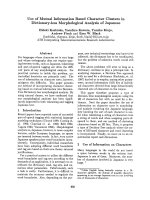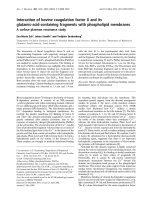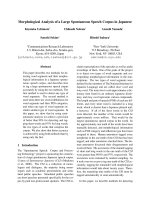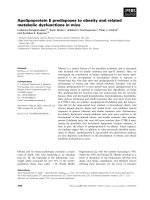Morphological analysis of Apolipoprotein E binding to Aβ Amyloid using a combination of Surface Plasmon Resonance, Immunogold Labeling and Scanning Electron Microscopy
Bạn đang xem bản rút gọn của tài liệu. Xem và tải ngay bản đầy đủ của tài liệu tại đây (1.33 MB, 7 trang )
Islam et al. BMC Biotechnology
(2019) 19:97
/>
METHODOLOGY ARTICLE
Open Access
Morphological analysis of Apolipoprotein E
binding to Aβ Amyloid using a
combination of Surface Plasmon
Resonance, Immunogold Labeling and
Scanning Electron Microscopy
Tohidul Islam1, Anna L. Gharibyan1, Cheng Choo Lee2 and Anders Olofsson1*
Abstract
Background: Immunogold labeling in combination with transmission electron microscopy analysis is a technique
frequently used to correlate high-resolution morphology studies with detailed information regarding localization of
specific antigens. Although powerful, the methodology has limitations and it is frequently difficult to acquire a
stringent system where unspecific low-affinity interactions are removed prior to analysis.
Results: We here describe a combinatorial strategy where surface plasmon resonance and immunogold labeling
are used followed by a direct analysis of the sensor-chip surface by scanning electron microscopy. Using this
approach, we have probed the interaction between amyloid-β fibrils, associated to Alzheimer’s disease, and
apolipoprotein E, a well-known ligand frequently found co-deposited to the fibrillar form of Aβ in vivo. The results
display a lateral binding of ApoE along the amyloid fibrils and illustrates how the gold-beads represent a good
reporter of the binding.
Conclusions: This approach exposes a technique with generic features which enables both a quantitative and a
morphological evaluation of a ligand-receptor based system. The methodology mediates an advantage compared
to traditional immunogold labeling since all washing steps can be monitored and where a high stringency can be
maintained throughout the experiment.
Keywords: Aβ, ApoE, Immunogold, Surface plasmon resonance, SPR, Scanning electron microscopy, SEM, Fibrils,
Morphology, Abeta
Background
Fibrillar aggregates of the amyloid β peptide (Aβ) are
considered as one of the hallmarks of AD and their ultrastructural morphology and properties have been extensively studied. The Aβ-fibrils are represented by a βsheet polymer where the lateral assembly of several thinner filaments constitute the final fibrillar morphology
[1–3]. The formation of Aβ amyloid fibrils follows a
nucleation-dependent path of aggregation. Here an
* Correspondence:
1
Department of Medical Biochemistry and Biophysics, Umeå University,
SE-901 87 Umeå, Sweden
Full list of author information is available at the end of the article
initially formed assembly of peptides acts as a template
(a nucleus) for the subsequent incorporation of monomers resulting in a highly ordered fibrillar morphology
of indefinite length. Similar to the growth of a crystal, a
repeating structure is propagated. Although a single fibril represents a highly ordered structure a morphological heterogeneity is frequently observed and several
fibrillar forms can usually be identified within the same
sample. Understanding the mechanistic details of Aβ assemblies is of interest in the design of therapeutic interventions [4, 5]. In vivo, the intrinsic properties of the Aβ
peptide to form an amyloid are suppressed by several
factors including degradation by neprilysin [6] and
© The Author(s). 2019 Open Access This article is distributed under the terms of the Creative Commons Attribution 4.0
International License ( which permits unrestricted use, distribution, and
reproduction in any medium, provided you give appropriate credit to the original author(s) and the source, provide a link to
the Creative Commons license, and indicate if changes were made. The Creative Commons Public Domain Dedication waiver
( applies to the data made available in this article, unless otherwise stated.
Islam et al. BMC Biotechnology
(2019) 19:97
insulin-degrading enzyme [7]. A few endogenous proteins have also been found to interfere with the process
of Aβ amyloid formation, including proteins containing
a BRICHOS domain [8–10], transthyretin (TTR) [11–
15], clusterin [16], and ApoE [17–20]. ApoE is in this
context of specific interest where the ε4 allele today represents the strongest genetic linker to the development
of late onset AD [21]. Identification of the mechanism of
binding including a morphological evaluation of the
binding pattern is therefore of interest.
Immunogold labeling in combination with electron
microscopy represents a technique used for the ultrastructural investigation of biological samples. The methodology reports the binding of e.g. an antibody to its
antigen or a ligand to its receptor by conjugation to a
gold particle and hence facilitates detailed structural information of the ultrastructural morphology. Immunogold techniques are however frequently hampered by the
ability to remove unspecific low-affinity binding and
hence to obtain a high stringency of the system. Consequently, it is often difficult to discriminate between relevant binding and non-specific interactions.
Within the SPR technique, the sample for analysis is
frequently attached to a surface via strong covalent
bonds and the immobilized proteins can then be probed
by potential interaction partners through injections into
a continuous flow of the media. The methodology facilitates detailed monitoring of binding kinetics including
KD determination [22]. It is hence easy to monitor the
removal of unspecific low-affinity interactions and the
stringency of the system.
An SPR experiment frequently involves the acquired
kinetic data from an interaction between e.g. a receptor
and its ligand and in most cases this covers the required
needs. The SPR technique has however been extensively
used regarding the monitoring of amyloid formation
[23–26] where a fibrillar ultrastructure is formed. Since
Page 2 of 7
an SPR chip is coated with a gold-surface it is amenable
for SEM analysis which facilitates a direct morphological
analysis of the formed structure on the surface. Within
this work, we have studied the interaction between Aβ
fibrils and ApoE where we, in addition, demonstrate
how the technique of immunogold labeling can be combined to illustrate the binding pattern. Using this approach, the kinetics of the probed ligands, as well as the
washing of each step to remove low and unspecific binding can be monitored prior to the morphological
analysis.
Results
Amyloid formation of Aβ1–40 monitored by Thioflavin T
(ThT) assay and TEM
Aβ1–40 readily forms fibrils under stagnant solutions in
PBS and the relative proportion of fibrillar material can
be monitored by using the amyloid-specific probe ThT.
Figure 1a illustrates the kinetics of conversion of monomeric Aβ1–40 to a fibrillar form, where the initial lagphase is followed by a logarithmic phase of fibril assembly, and subsequently reaches a plateau, where most of
the monomeric fraction is converted to mature fibrils.
Figure 1b illustrates a representative negative stain TEM
image of the fibrils formed at the end of ThT kinetics
wherein overall fibrillar morphology is developed.
Surface Plasmon resonance
To study the binding of ApoE to Aβ1–40 fibrils using
both SPR and SEM a scheme of analysis to include all
controls was employed. In total 2000 response units
(RU) of Aβ1–40 fibrils were immobilized and then probed
with ApoE until saturation binding had been acquired
implicating that most of the accessible sites have been
occupied (Fig. 2a). The KD of the binding between fibrils
and recombinant human ApoE4 is strong and was calculated here to be around 5 nM, which is in overall good
Fig. 1 ThT and TEM analysis of fibril formation of Aβ1–40. a 20 μM monomeric peptide solution of Aβ1–40 was incubated in the presence of 40 μM
of the amyloid reporting probe ThT. A steady state of the plateau indicates that monomeric fraction has been consumed and converted to the
fibrillar form. b Negative uranyl acetate staining of the Aβ1–40 fibrils analyzed by TEM. Scale bar is 100 nm
Islam et al. BMC Biotechnology
(2019) 19:97
Page 3 of 7
Fig. 2 SPR analysis facilitates sequential probing of ApoE, anti-ApoE antibody and protein-A conjugated gold-particle. SPR analysis of a ApoE4
binding to immobilized Aβ1–40 fibrils, b ApoE4 bound Aβ1–40 fibrils probed with anti-ApoE antibodies, and c Protein-A gold beads binding to the
fibril-ApoE-antibody complex. The analysis was performed in degassed PBS at pH 7.4
agreement with previous investigations [27, 28]. Bound
ApoE4 was then probed through the addition of an antiApoE antibody, Fig. 2b. The removal of an excess of
antibodies was effectively monitored using the SPR trace.
As a last step 15 nm gold-beads conjugated to Protein-A
was added and the binding monitored in analogy to previous steps, Fig. 2c.
SEM-analysis of the CM5-chip surface
Due to the conducting substrate (gold-surface of the
CM5-chip) it is possible to make direct analysis by SEM.
Ultra- small (diameters < 10 nm), yet non-conducting
materials such as the amyloid fibrils can be distinguished
from the background by the inelastic electron scattering
when the electron beam hits the sample surface at low
accelerating voltage. The low-energy secondary electrons, detected by the in-lens detector, provide highresolution, surface-sensitive information, as well as
compositional contrast, displaying darker shades of gray
for the organic matter (fibrils) and brighter gray level for
the heavier elements (gold beads). The gold-beads indirectly probing bound ApoE could be readily identified
due to their strong electron scattering properties and
therefore easily discriminated from the background of
both the gold-surface of the CM5-chip and the immobilized fibrillar sample. Figure 3a indicates a control surface area where all components of the described system,
apart from ApoE, has been added.
The results revealed a fibrillar morphology in accordance with the TEM analysis of the corresponding sample
and in essence no background binding is anti-ApoE antibodies and the subsequently added protein-A coated
gold-beads was observed. Figure 3b shows the morphology of the sample after all components have been included. The results show how ApoE laterally decorates
the amyloid fibrils, which is in accordance with previous
Fig. 3 SEM analysis of the SPR-chip surface. a Control sample in absence of added ApoE to probe for non-specific binding where the
immobilized fibrils on the SPR-chip have been sequentially probed with anti-ApoE antibodies and protein-A conjugated 15 nm gold-beads. b
Complete setup where fibrils bound to the SPR-chip have been sequentially probed with ApoE4, anti-ApoE antibodies and protein-A conjugated
15 nm gold-beads. Scale bar is 100 nm
Islam et al. BMC Biotechnology
(2019) 19:97
findings using traditional immunogold techniques in
combination with TEM [29, 30]. An apparent discrepancy can here be observed between different fibrils.
While some fibrils are highly covered by the gold-beads
others essentially completely lack any binding of ApoE,
thus showing the absence of gold-beads. We observe the
phenomenon of ApoE selectivity binding to certain fibrillar subtypes. However, due to the relatively low imaging resolution of SEM (compared to TEM) it is at this
point of writing difficult to conclude if this is a technical
artefact or if the observed results is based on a selectivity
of ApoE for different types of fibrillar morphology.
Discussion
Gold-particles have been used within the field of electron microscopy for a very long time due to their remarkable electron density and are today available in
different sizes and conjugated to different linker molecules [31, 32]. In the present study we described an alternative immunogold labeling approach by using a
combination of SPR and SEM to achieve both quantitative and morphological evaluation of the sample.
A limiting factor regarding the traditional use of
immunogold techniques is that the sample is not
strongly immobilized onto the surface. This feature frequently hampers the removal of unspecific binding after
probing with e.g. antibodies or ligands and it is as a consequence difficult to acquire a good signal to noise ratio
since an appropriate washing is difficult to perform and
monitor. Sample preparation for TEM is also frequently
associated with negative staining using a water solution
of uranyl-acetate having pH between 4 and 5 which also
may compromise the binding and may cause dissociation
of assembled protein complexes.
Present work is focused on the interaction between the
amyloid form of Aβ and its well-known ligand ApoE
where in particular the ApoE ε4 allele is associated with a
significantly increased risk of developing the disease [21,
33]. Through the current approach the fibrillar forms of
the Aβ peptide are covalently attached to the activated
SPR surface of a CM5-chip. After immobilization the sample is washed by a continuous flow of PBS to acquire a
steady baseline and a sample amenable for the probing
with ligands according to standard procedures. Detection
of bound ApoE was further performed by an anti-ApoE
antibody followed by protein-A conjugated to 15 nm gold
beads. Apart from the possibility to determine the binding
affinities and kinetics of the binding the technique enables
monitoring of all washing steps where e.g. low affinity interactions effectively can be removed.
The procedure in more general terms exposes a strategy
that may be employed also in other contexts and serves as
a versatile tool whenever the ultra-structural morphology
is of interest in combination with binding kinetics.
Page 4 of 7
Interestingly, we observed an unexpected discrepancy
where ApoE frequently did not bind uniformly to all fibrils within a sample. While certain fibrils were highly
covered with ApoE, others in essence completely lacked
bound ApoE. While this may be a technical artefact an
alternative option is that ApoE may have a selective affinity for certain fibrillar morphologies. Although a single fiber follows a very high structural order, similar to
the formation of a crystal, fibrils may differ from each
other and Aβ samples frequently expose heterogeneous
fibril morphology [1–3, 34]. This can be easily observed
by TEM and is also seen within the fibrillar samples
used here (shown in Fig. 1b) where at least four different
types of fibril morphologies can be identified. The discrepancy in binding (shown in the SEM images) may indicate that ApoE selectively attaches to certain fibrillar
structures. While SEM is desirable for direct analysis of
amyloid fibrils on SPR-chip, the strong background signals and non-featureless morphology of the gold-surface
may prohibit detailed investigation of the fibrils. Future
studies are therefore required to distinguish if this is a
technical artefact or if ApoE may have a different selectivity for different fibrillar morphologies.
Taken together, we have demonstrated a combinatorial immunogold-labeling approach using SPR and SEM,
which allows improving the stringency of the system of
analysis. The setup facilitates both quantitative and morphological evaluation where importantly an efficient
binding and washing can be monitored between each
step in the sequential experimental approach defining
the immunogold technique. The technique is in essence
applicable to most setups using SPR where an ultrastructural morphology also is of interest. A schematic illustration of the setup is shown in Fig. 4.
Methods
Preparation of ApoE4 and Aβ1–40 monomers
Recombinant lyophilized ApoE4, as well as recombinant
lyophilized Aβ1–40 peptides, were obtained from AlexoTech AB (Umeå, Sweden). Aβ1–40 was dissolved in 20
mM NaOH while both ApoE was dissolved in PBS. To
remove potential aggregates both ApoE as well as Aβ1–
40 were subjected to size-exclusion chromatography
(Superdex 75 10/300, GE Life Science, Uppsala, Sweden)
in degassed PBS at 4 °C prior to its use. Both Aβ1–40 as
well as ApoE eluted as a single peak.
Preparation of Aβ1–40 fibrils
In order to prepare Aβ1–40 fibrils, freshly gel-filtrated
monomeric Aβ in PBS was distributed in a 96-well microtiter plate with dark walls and clear bottom (Cat.
No.3881, Corning, USA) to a final concentration of
20 μM and incubated at 37 °C in the presence of 40 μM
ThT. The aggregation process was monitored by
Islam et al. BMC Biotechnology
(2019) 19:97
Page 5 of 7
Fig. 4 Schematic illustration of the setup using immunogold staining in combination with SPR and SEM
recording the ThT signal using a fluorescence microplate reader (Tecan Infinite 200Pro, Männedorf,
Switzerland) with excitation at 440 nm and emission at
480 nm according to standard procedures [35]. Fibrillar
samples were considered ready when the binding of ThT
reached a plateau.
Negative staining transmission electron microscopy (TEM)
Prepared Aβ1–40 fibrils were sonicated for 60 s in a water
bath and a total volume of 3.5 μl of fibrils was applied to
300 mesh formvar/carbon-coated, glow-discharged Nigrids. After 1.5 min, the grid was washed in distilled
water and consequently negatively stained for 15 s with
1.5% uranyl acetate (TAAB, Berks, England). Finally, fibrils were examined under a Talos L120 TEM (FEI)
microscope (120 kV) equipped with a Ceta CMOS 4 k ×
4 k pixel (FEI) camera supported with the FEI TIA
(TEM imaging and analysis).
Surface plasmon resonance
The interaction between Aβ fibrils and ApoE was monitored using a BIAcore 3000 biosensor (GE Healthcare,
Uppsala, Sweden) equipped with a CM5 sensor chip (GE
Healthcare). Prior to fibril immobilization the dextran
matrix on the sensor chip surface was activated with a
mixture of 1-ethyl-3- (3-dimethylaminopropyl) carbodiamide (EDC) and N-hydroxysuccinimide (NHS). Aβ fibrils
were immobilized at a density of 2000 response unit (RU)
using standard amino coupling reagents and then deactivated according to the manufacture instruction. All SPR
experiments were performed in degassed PBS at 25 °C.
Fibrils were immobilized at a flow rate of 5 μL/min,
whereas Aβ1–40 monomeric peptide solution, ApoE4,
Anti-ApoE (rabbit polyclonal, Cat# PA5–27088, ThermoFisher Scientific) and 15 nm protein-A gold beads (CMC
Utrecht, Netherlands) were injected at a flow rate of
20 μL/min. All the steps were followed by a 5 min flow of
buffer, and after the final step additionally washed by degassed distilled water for 5 min at a flow rate of 50 μL/
min. Biosensor data were processed by BioLogic Software
Scrubber2 and sensograms were made using GraphPad
Prism 5.01.
Scanning electron microscopy (SEM)
Prior to analysis the SPR chip was disassembled and
mounted onto an aluminium stub using carbon adhesive
tape and a copper tape is applied between the chip surface
and metal stub for proper electrical grounding. The sample
morphology was examined by field-emission scanning electron microscope (FESEM; Carl Zeiss Merlin GmbH) using
an in-lens secondary electron (SE) detector at an accelerating voltage of 3 kV and probe current of 90 pA. The immobilized and Au-labelled fibrils can be directly visualized at
low beam accelerating voltage without the application of a
thin metal coating. Furthermore, no additional steps of
sample processing are required e.g. fixation, dehydration
and drying.
Abbreviations
AD: Alzheimer’s disease; ApoE: Apolipoprotein E; Aβ: Amyloid β peptide;
KD: Dissociation constant; RU: Response units; SEM: Scanning electron
microscopy; SPR: Surface plasmon resonance; TEM: Transmission electron
microscopy; ThT: Thioflavin T; TTR: Transthyretin
Islam et al. BMC Biotechnology
(2019) 19:97
Acknowledgements
Linnéa Olofsson for critically reviewing the manuscript.
Authors’ contributions
TI and CCL performed the experiments. AO, TI, ALG and CCL conceived the
idea and wrote the manuscript.
Funding
This work was supported by the National Microscopy Infrastructure, NMI (VR-RFI
2016–00968) at the Umeå Core Facility for Electron Microscopy, Demensförbundet,
Insamlingsstiftelsen at Umeå University, Åhlén-stiftelsen, Hjärnfonden, FAMYNorrbotten, Olle Engkvist stiftelse (199-0469) and the Medical Faculty of Umeå University. The funders have no role in the design of the study, data collection or interpretation of data. Open access funding provided by Umea University.
Ethics approval and consent to participate
Not applicable.
Availability of data and material
Not applicable.
Consent for publication
Not applicable.
Competing interests
The authors declare that they have no competing interests.
Author details
1
Department of Medical Biochemistry and Biophysics, Umeå University,
SE-901 87 Umeå, Sweden. 2Umeå Core Facility for Electron Microscopy
(UCEM), Umeå University, SE-90187 Umeå, Sweden.
Received: 13 July 2019 Accepted: 27 November 2019
References
1. Fandrich M, Meinhardt J, Grigorieff N. Structural polymorphism of Alzheimer
Abeta and other amyloid fibrils. Prion. 2009;3(2):89–93.
2. Meinhardt J, Sachse C, Hortschansky P, Grigorieff N, Fandrich M. Abeta(1-40)
fibril polymorphism implies diverse interaction patterns in amyloid fibrils. J
Mol Biol. 2009;386(3):869–77.
3. Paravastu AK, Leapman RD, Yau WM, Tycko R. Molecular structural basis for
polymorphism in Alzheimer’s beta-amyloid fibrils. Proc Natl Acad Sci USA.
2008;105(47):18349–54.
4. Herling TW, Levin A, Saar KL, Dobson CM, Knowles TPJ. Microfluidic
approaches for probing amyloid assembly and behaviour. Lab Chip. 2018;
18(7):999–1016.
5. Meisl G, Michaels TCT, Linse S, Knowles TPJ. Kinetic analysis of amyloid
formation. Methods Mol Biol. 2018;1779:181–96.
6. Iwata N, Tsubuki S, Takaki Y, Watanabe K, Sekiguchi M, Hosoki E, KawashimaMorishima M, Lee HJ, Hama E, Sekine-Aizawa Y, et al. Identification of the
major Abeta1-42-degrading catabolic pathway in brain parenchyma:
suppression leads to biochemical and pathological deposition. Nat Med.
2000;6(2):143–50.
7. Jiang Q, Lee CY, Mandrekar S, Wilkinson B, Cramer P, Zelcer N, Mann K,
Lamb B, Willson TM, Collins JL, et al. ApoE promotes the proteolytic
degradation of Abeta. Neuron. 2008;58(5):681–93.
8. Biverstal H, Dolfe L, Hermansson E, Leppert A, Reifenrath M, Winblad B,
Presto J, Johansson J. Dissociation of a BRICHOS trimer into monomers
leads to increased inhibitory effect on Abeta42 fibril formation. Biochim
Biophys Acta. 2015;1854(8):835–43.
9. Buxbaum JN, Johansson J. Transthyretin and BRICHOS: the paradox of
Amyloidogenic proteins with anti-Amyloidogenic activity for Abeta in the
central nervous system. Front Neurosci. 2017;11:119.
10. Willander H, Presto J, Askarieh G, Biverstal H, Frohm B, Knight SD, Johansson
J, Linse S. BRICHOS domains efficiently delay fibrillation of amyloid betapeptide. J Biol Chem. 2012;287(37):31608–17.
11. Buxbaum JN, Ye Z, Reixach N, Friske L, Levy C, Das P, Golde T, Masliah E,
Roberts AR, Bartfai T. Transthyretin protects Alzheimer’s mice from the
behavioral and biochemical effects of Abeta toxicity. Proc Natl Acad Sci
USA. 2008;105(7):2681–6.
Page 6 of 7
12. Cascella R, Conti S, Mannini B, Li X, Buxbaum JN, Tiribilli B, Chiti F, Cecchi C.
Transthyretin suppresses the toxicity of oligomers formed by misfolded
proteins in vitro. Biochim Biophys Acta. 2013;1832(12):2302–14.
13. Garai K, Posey AE, Li X, Buxbaum JN, Pappu RV. Inhibition of amyloid
beta fibril formation by monomeric human transthyretin. Protein Sci.
2018;27(7):1252–61.
14. Mangrolia P, Yang DT, Murphy RM. Transthyretin variants with improved
inhibition of beta-amyloid aggregation. Protein Eng Des Sel. 2016;29(6):
209–18.
15. Nilsson L, Pamren A, Islam T, Brannstrom K, Golchin SA, Pettersson N,
Iakovleva I, Sandblad L, Gharibyan AL, Olofsson A. Transthyretin interferes
with Abeta amyloid formation by redirecting Oligomeric nuclei into nonamyloid aggregates. J Mol Biol. 2018;430(17):2722–33.
16. Hammad SM, Ranganathan S, Loukinova E, Twal WO, Argraves WS.
Interaction of apolipoprotein J-amyloid beta-peptide complex with low
density lipoprotein receptor-related protein-2/megalin. A mechanism to
prevent pathological accumulation of amyloid beta-peptide. J Biol Chem.
1997;272(30):18644–9.
17. Cerf E, Gustot A, Goormaghtigh E, Ruysschaert JM, Raussens V. High ability of
apolipoprotein E4 to stabilize amyloid-beta peptide oligomers, the pathological
entities responsible for Alzheimer’s disease. FASEB J. 2011;25(5):1585–95.
18. Hashimoto T, Serrano-Pozo A, Hori Y, Adams KW, Takeda S, Banerji AO,
Mitani A, Joyner D, Thyssen DH, Bacskai BJ, et al. Apolipoprotein E,
especially apolipoprotein E4, increases the oligomerization of amyloid beta
peptide. J Neurosci. 2012;32(43):15181–92.
19. Ly S, Altman R, Petrlova J, Lin Y, Hilt S, Huser T, Laurence TA, Voss JC.
Binding of apolipoprotein E inhibits the oligomer growth of amyloid-beta
peptide in solution as determined by fluorescence cross-correlation
spectroscopy. J Biol Chem. 2013;288(17):11628–35.
20. Ghosh S, Sil TB, Dolai S, Garai K. High-affinity multivalent interactions
between apolipoprotein E and the oligomers of amyloid-beta. FEBS J. 2019;
/>21. Corder EH, Saunders AM, Strittmatter WJ, Schmechel DE, Gaskell PC, Small
GW, Roses AD, Haines JL, Pericak-Vance MA. Gene dose of apolipoprotein E
type 4 allele and the risk of Alzheimer’s disease in late onset families.
Science. 1993;261(5123):921–3.
22. Drescher DG, Selvakumar D, Drescher MJ. Analysis of protein interactions by
surface Plasmon resonance. Adv Protein Chem Struct Biol. 2018;110:1–30.
23. Brannstrom K, Islam T, Gharibyan AL, Iakovleva I, Nilsson L, Lee CC, Sandblad
L, Pamren A, Olofsson A. The properties of amyloid-beta fibrils are
determined by their path of formation. J Mol Biol. 2018;430(13):1940–9.
24. Brannstrom K, Islam T, Sandblad L, Olofsson A. The role of histidines in
amyloid beta fibril assembly. FEBS Lett. 2017;591(8):1167–75.
25. Brannstrom K, Ohman A, Lindhagen-Persson M, Olofsson A. Ca(2+)
enhances Abeta polymerization rate and fibrillar stability in a dynamic
manner. Biochem J. 2013;450(1):189–97.
26. Brannstrom K, Ohman A, Olofsson A. Abeta peptide fibrillar architectures
controlled by conformational constraints of the monomer. PLoS One. 2011;
6(9):e25157.
27. Yamauchi K, Tozuka M, Nakabayashi T, Sugano M, Hidaka H, Kondo Y,
Katsuyama T. Higher avidity binding of apolipoprotein (E-AII) complex than of
apolipoprotein E monomer to beta-amyloid. J Neurosci Res. 1999;58(2):301–7.
28. Golabek AA, Soto C, Vogel T, Wisniewski T. The interaction between
apolipoprotein E and Alzheimer’s amyloid beta-peptide is dependent on
beta-peptide conformation. J Biol Chem. 1996;271(18):10602–6.
29. Garai K, Verghese PB, Baban B, Holtzman DM, Frieden C. The binding of
apolipoprotein E to oligomers and fibrils of amyloid-beta alters the kinetics
of amyloid aggregation. Biochemistry. 2014;53(40):6323–31.
30. Sanan DA, Weisgraber KH, Russell SJ, Mahley RW, Huang D, Saunders A,
Schmechel D, Wisniewski T, Frangione B, Roses AD, et al. Apolipoprotein E
associates with beta amyloid peptide of Alzheimer’s disease to form novel
monofibrils. Isoform apoE4 associates more efficiently than apoE3. J Clin
Invest. 1994;94(2):860–9.
31. Faulk WP, Taylor GM. An immunocolloid method for the electron
microscope. Immunochemistry. 1971;8(11):1081–3.
32. Baschong W, Stierhof YD. Preparation, use, and enlargement of
ultrasmall gold particles in immunoelectron microscopy. Microsc Res
Tech. 1998;42(1):66–79.
33. Ma J, Yee A, Brewer HB Jr, Das S, Potter H. Amyloid-associated proteins
alpha 1-antichymotrypsin and apolipoprotein E promote assembly of
Alzheimer beta-protein into filaments. Nature. 1994;372(6501):92–4.
Islam et al. BMC Biotechnology
(2019) 19:97
34. Komatsu H, Feingold-Link E, Sharp KA, Rastogi T, Axelsen PH. Intrinsic linear
heterogeneity of amyloid beta protein fibrils revealed by higher resolution
mass-per-length determinations. J Biol Chem. 2010;285(53):41843–51.
35. Brannstrom K, Ohman A, Nilsson L, Pihl M, Sandblad L, Olofsson A. The Nterminal region of amyloid beta controls the aggregation rate and fibril
stability at low pH through a gain of function mechanism. J Am Chem Soc.
2014;136(31):10956–64.
Publisher’s Note
Springer Nature remains neutral with regard to jurisdictional claims in
published maps and institutional affiliations.
Page 7 of 7









